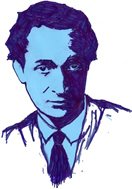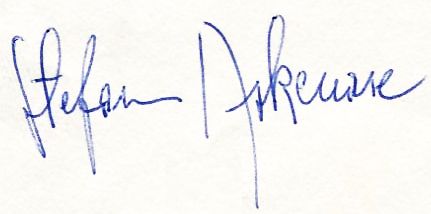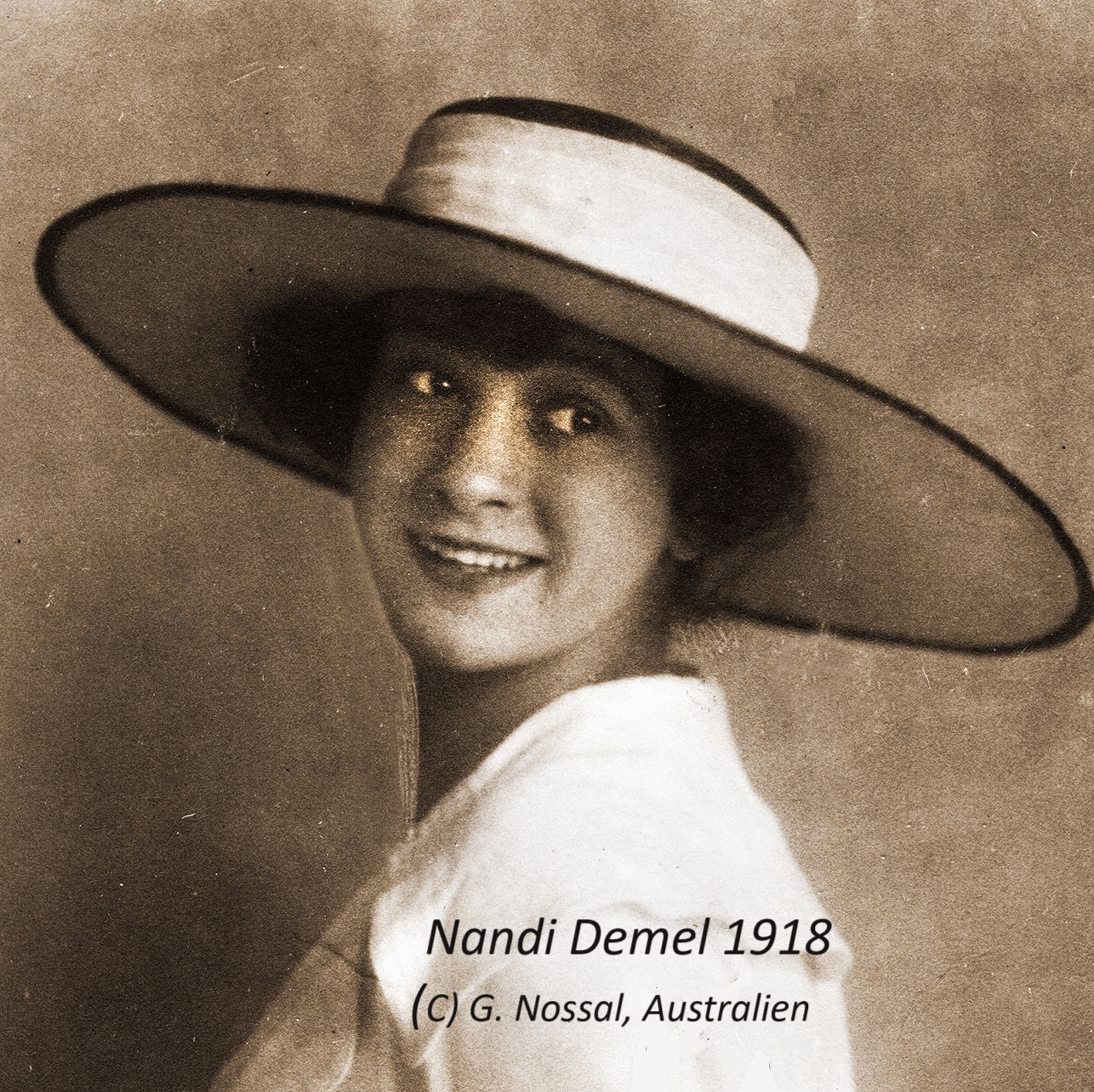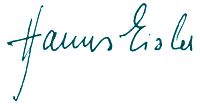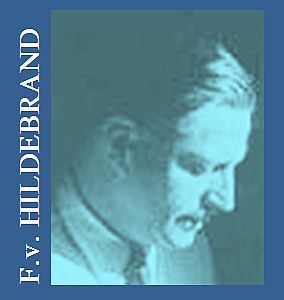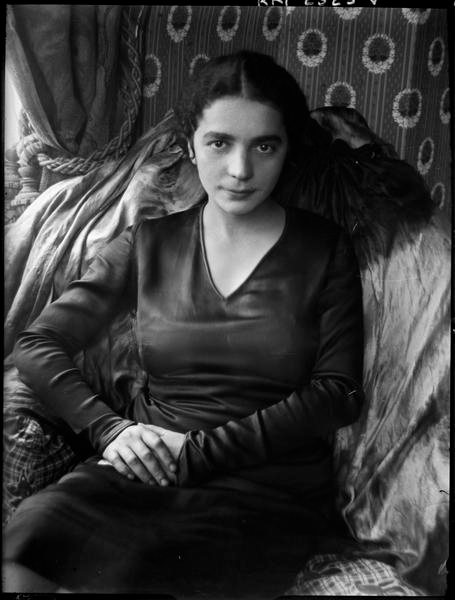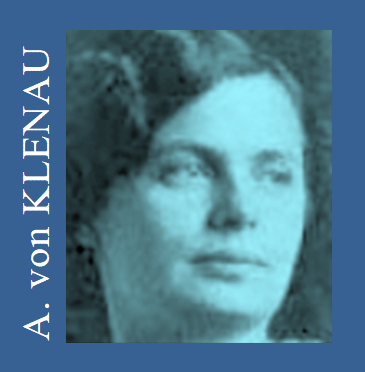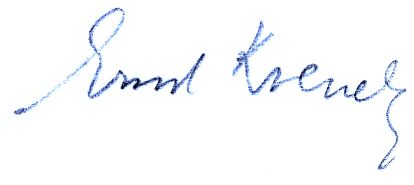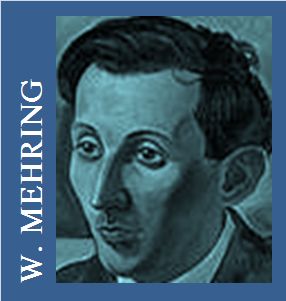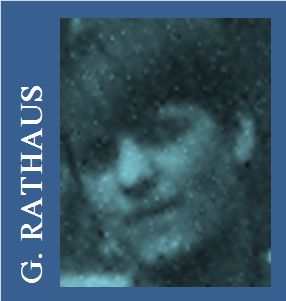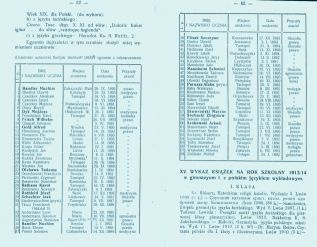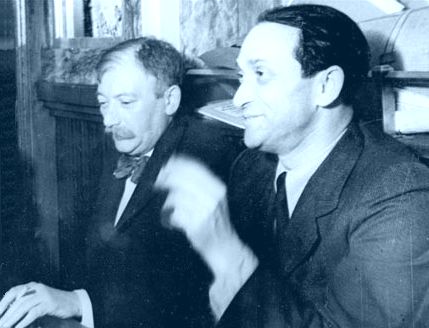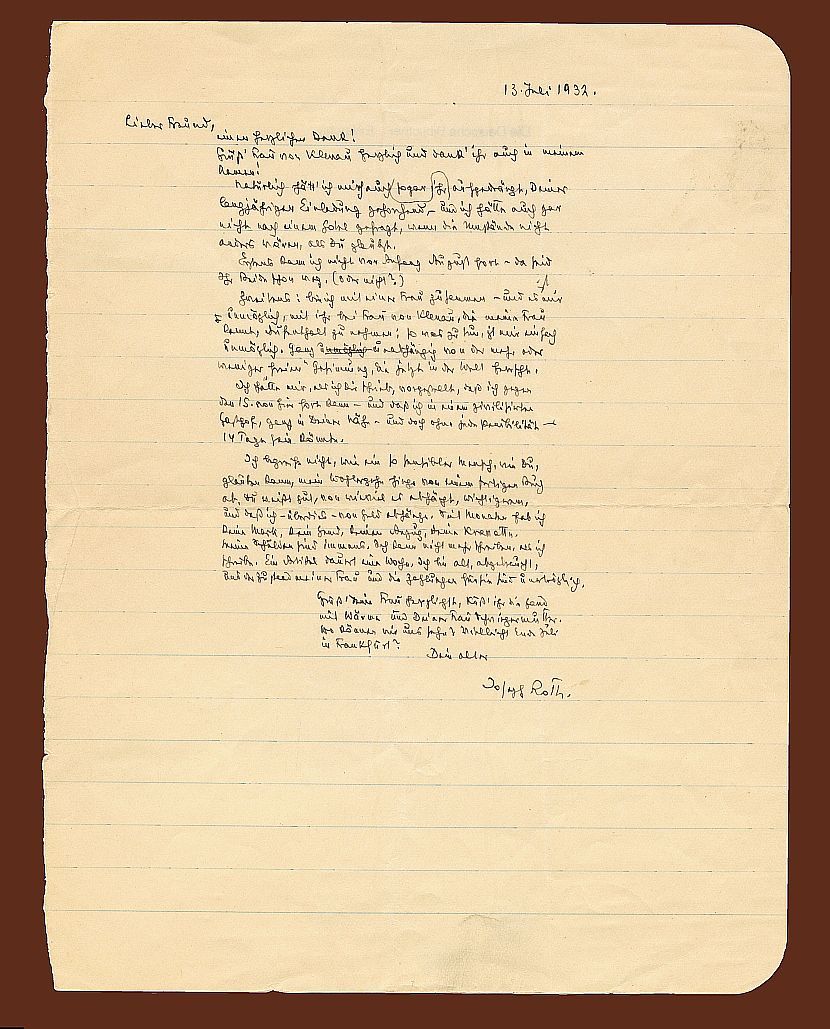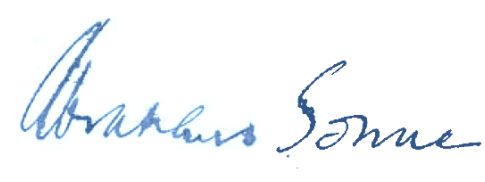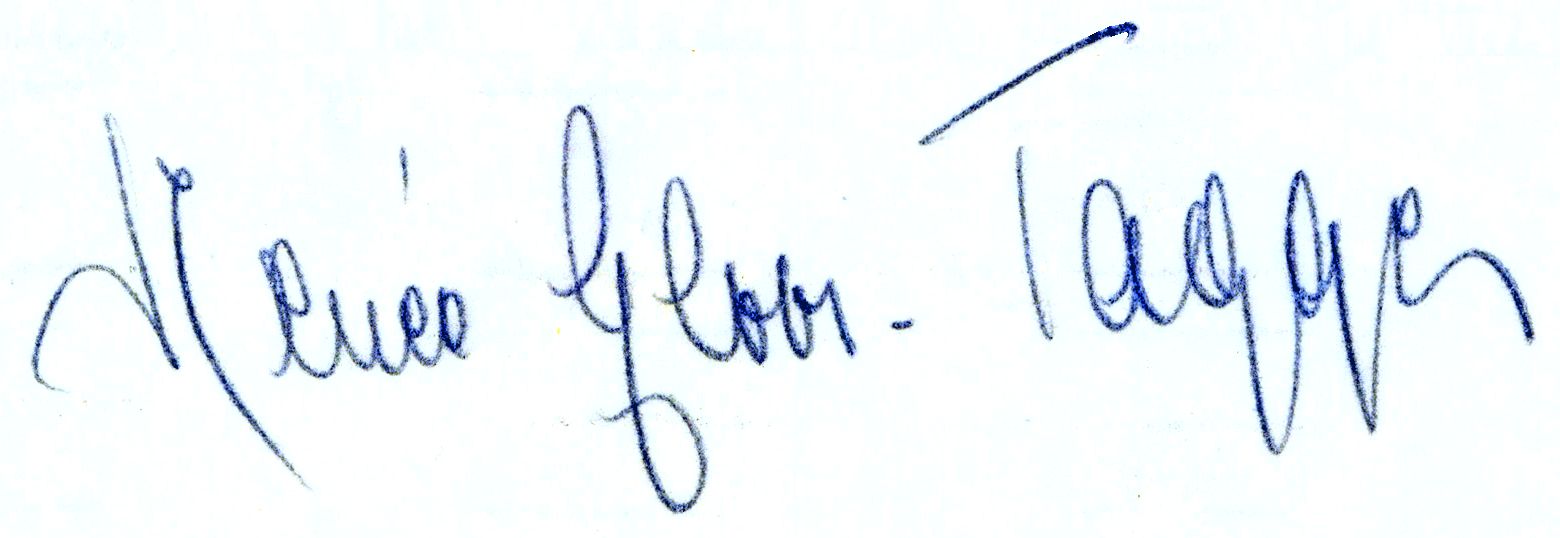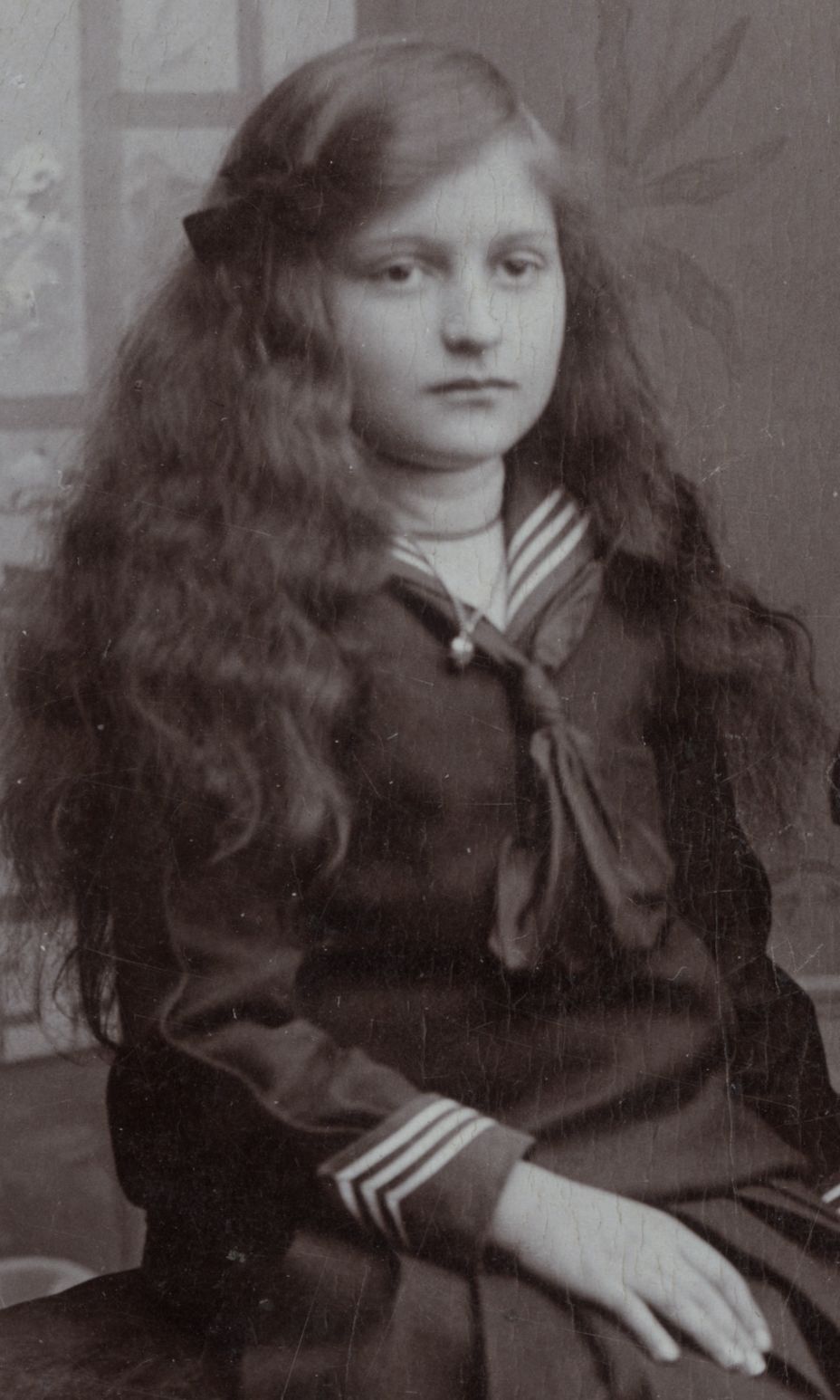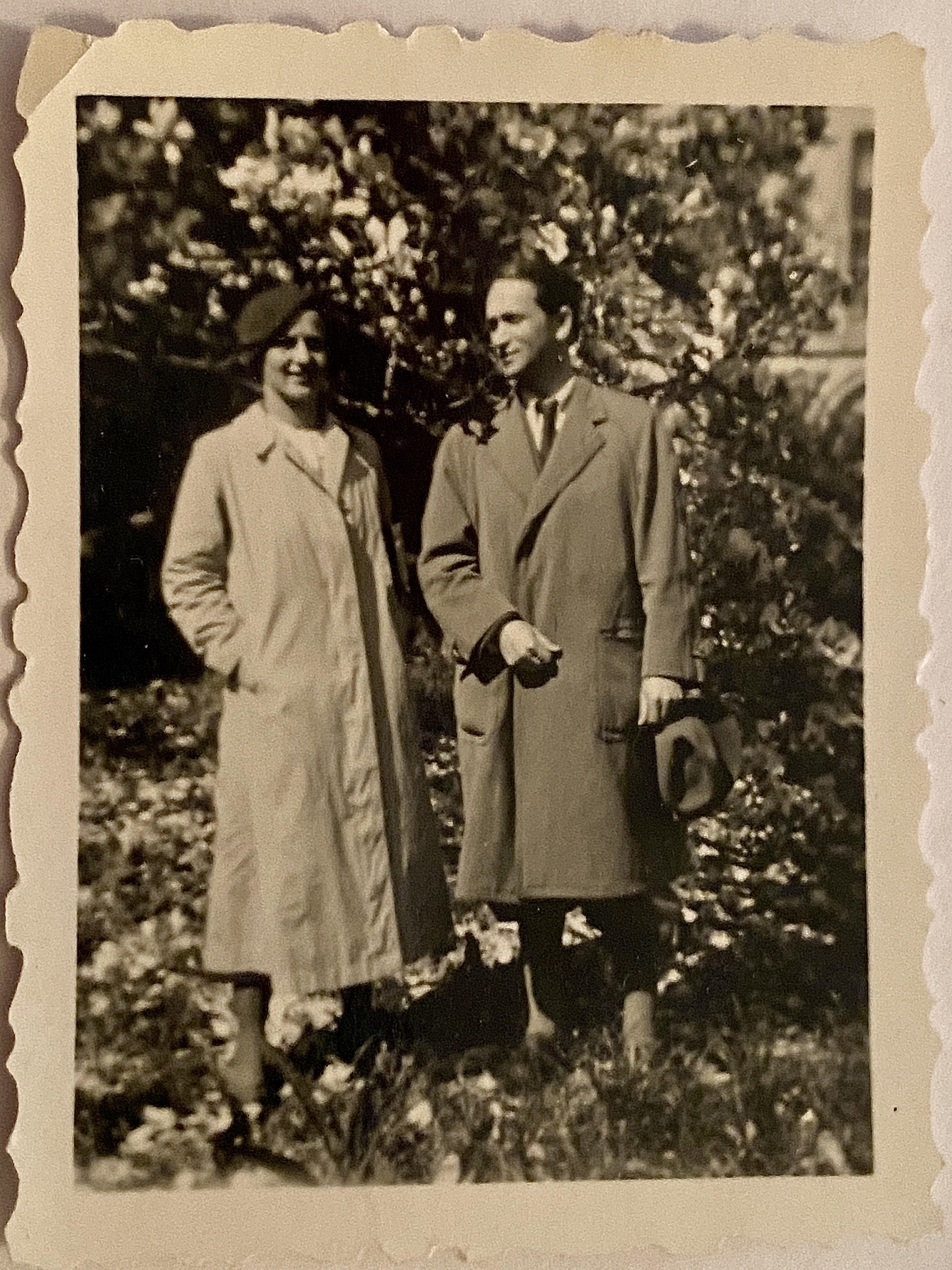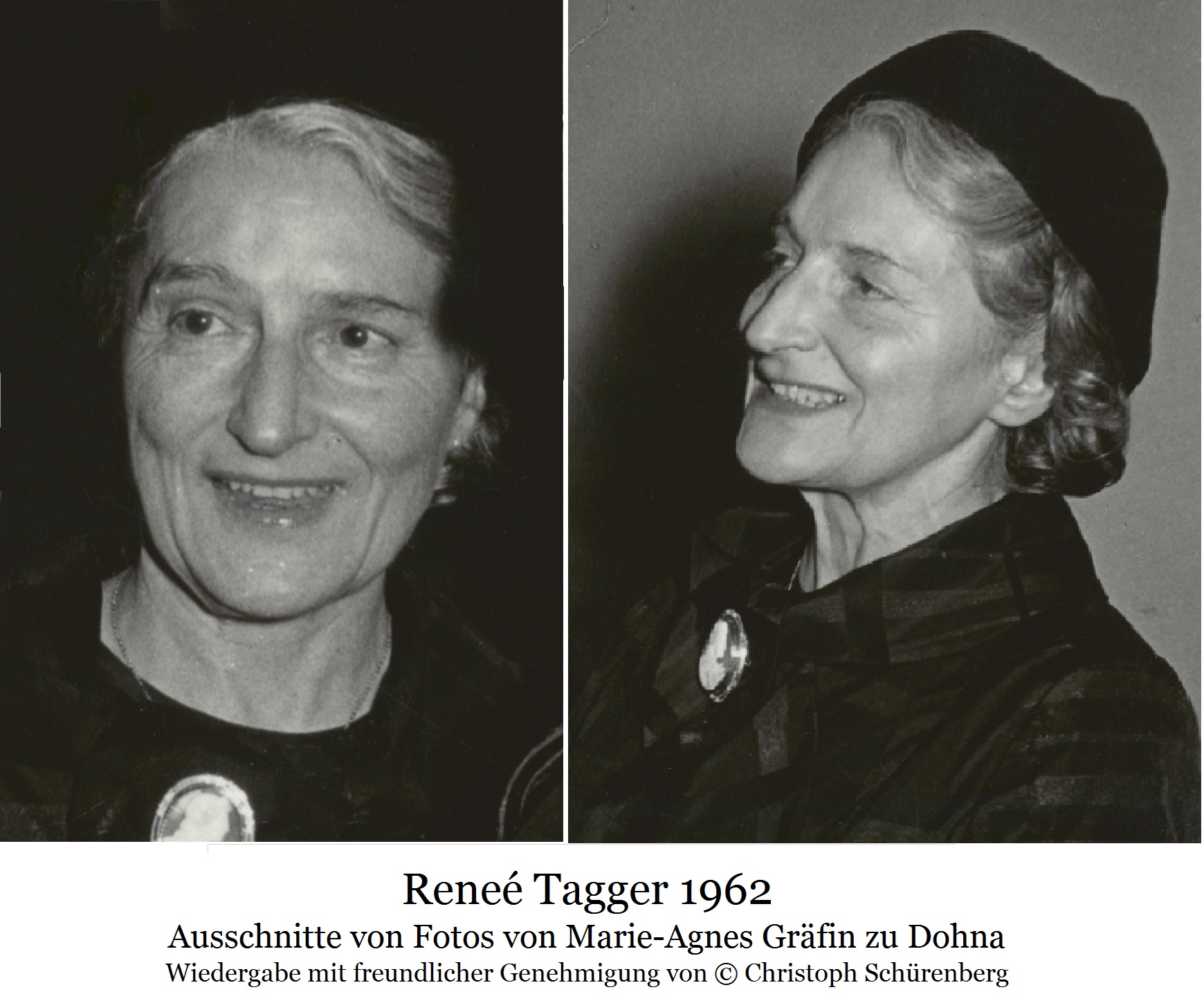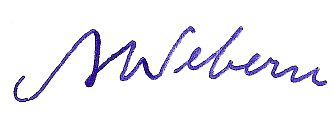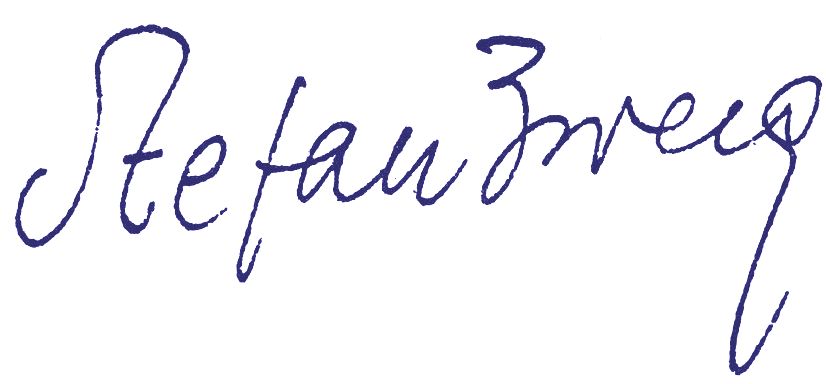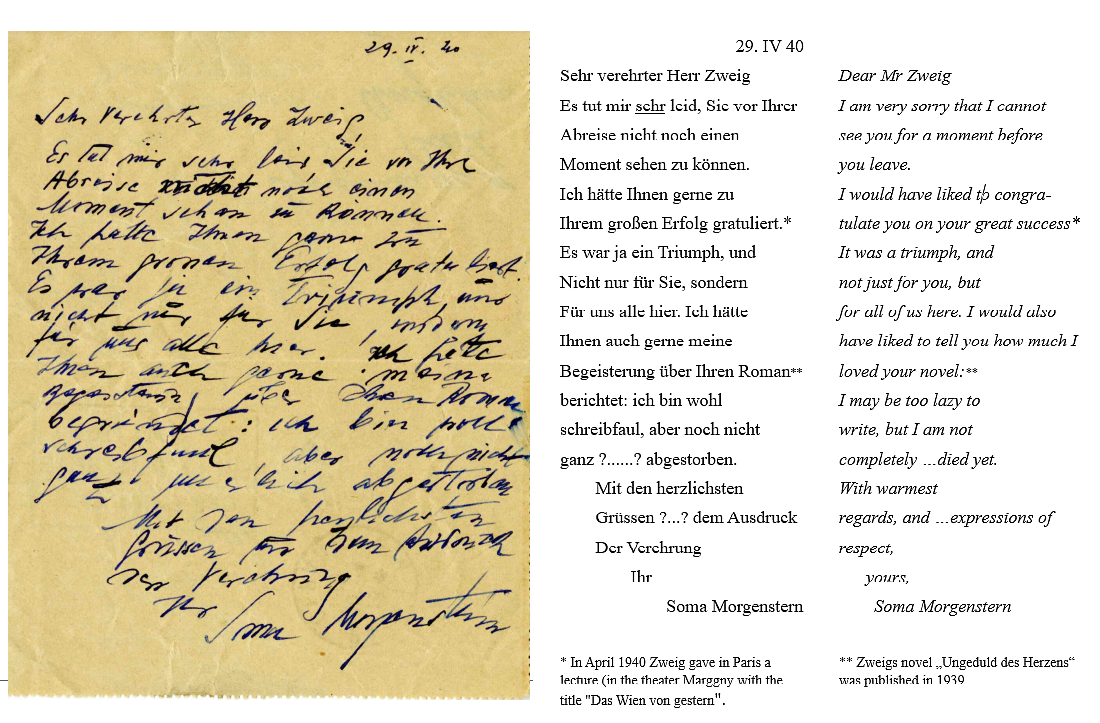„A LIFE WITH FRIENDS“ was the title Morgenstern initially had in mind for his memoirs. “As far as friendship is concerned I have been very lucky in my life. Without exaggeration I can say that this has been the boon of my existence. I have lived in untroubled friendship with many notable people; ones who should later become famous, like Joseph Roth, Alban Berg, Robert Musil, Otto Klemperer, Joseph Frank, Ernst Bloch, just to mention a few; and with many others, who did not gain as much fame, and many so-called mere mortals, who have been distinguished persons without any claim to fame, but who have been equally close, if not closer to my heart." (Original in German - SM, Berg p.122)
Classification of „Friends“ in this overview: SM has quite consistently labeled his friends as „my friend“ in his work. All persons indicated as such are included in this list, even in the rare cases where the friendship was clearly ceased (cf. Adorno or Hardt). SM uses the indication of “friend” so regularly that we assume that persons never indicated as such were not regarded by SM as friends, even if he held them in high esteem and had regular contact with them (as e.g. Anton Kuh or Egon Erwin Kisch, who are therefore not included in this list of “friends”). Some persons about whom no mention by SM is recorded are included in this list because of statements by others or because of the content of preserved correspondence. In a few cases relatively subjective decisions had to be taken: Hermann Kesten, whilst described by SM predominantly in a not entirely positive way apparently always acted as a good friend of SM and is included in this list. Maybe SM did not regard Friedrich Torberg as a friend; however, because of the favor Torberg did SM, he is included here as a friend. Hermann Thimig was probably close friends with SM in around 1925, however, SM never mentions this – I assume because of Thimig´s later friendly co-operation with the Nazis; he is not included in this list. There certainly there did exist some other good friends, who, however, are not identified here as such. Blood relatives, regardless of how friendly the relation was, are not included here.
Acquaintances who are not included in this list of FRIENDS can be found in the PERSON INDEX.
I intend to describe some of SM´s friends here in more detail – especially those about whom (and about relationship to SM) too little has been published in my view. Currently there are already more elaborate descriptions about three friends. For the time being, however, they are only in German:
The (not necessarily complete) long list of SMs friends (about 70 persons):
SOURCES – EXPLANATION OF THE REFERENCES:
[ ] Reference in SM´s autobiographic books with indication of page numbers in the German publication: Alban [Berg] und seine Idole; Joseph [Roth]s Flucht und Ende; In einer anderen [Zeit]; [KBT]: Kritiken, Berichte, Tagebücher. [Flucht] in Frankreich; [Blutsäule-Kommentar]: Morgenstern's afterword of the Hebrew edition of "The Third Pillar" is presented in the German edition of 1977 ("Blutsäule") on page 7-16 containing autobigraphical details.
(Indications between parentheses ( ) refer to texts of the editor Ingolf Schultes, his foot notes or afterword.)oder Nachwort ).
{DEA Number of received letters / used language(s) / location(s) letters sent / year(s)} : received correspondence in SM´s descendant’s estate in the Deutsche ExilArchiv (German exile archive in Frankfurt).
( ) Reference in other (secondary) sources. (RK) = Raphaela Kitzmantel: Eine Überfülle an Gegenwart – Soma Morgenstern biography
Persons mentioned with their names in Bold Italics are represented on this website with a separate entry (on “PERSONS” or “FRIENDS”); only occasionally an internal hyperlink is provided.
|
|
*Theodor W. ADORNO se → WIESENGRUND |
|
|
|
|
>>internet site with photo 1976 |
*Lotte ANDOR (PALFI; née MOSBACHER) (1903 Bochum – 1991 New York) German-American actress with Jewish family background. Initially at theater (including in Vienna); 1934 together with her first husband, the film editor Victor Palfi, she escaped to the USA; there they divorced. 1939-1944 small film roles in Hollywood, e.g. in Casablanca. Contacts with German expatriate circles in American exile (including Bert Brecht), on friendly terms with Ludwig Hardt. 1943 marriage with the actor Wolfgang Zilzer alias Paul Andor (divorced in 1991 shortly before their death). 1945 to New York, secretary at the New York University, in addition small roles in theater, television and movies. After a long break an appearance in Marathon Man (1976; with Laurence Oliver, Dustin Hoffman). Her memoirs were published with the title „Die Fremden Jahre“ (The foreign years) as a 50-page typescript „Ich war nie ein Bernhardiner - Memoiren einer unbekannten Schauspielerin“ (I never was a St. Bernhard dog. Memoirs of an unknown actress.). The (bitter) memories are recorded 1981 with a conciliative addendum of 1983, when the Andors were invited to the Berlinale (the film festival in Berlin), where they had been honored. After the war Lotte Andor was a close friend of SM in New York; she worked together with him: substantial parts of SM´s recorded memoir were written down by him, but were instead dictated to Lotte Andor by him. Lotte Andor does not mention SM in her memoirs – after all, her memoirs end at the year 1944. (SM also does not mention her in his memory notes.) At the end of her notes she writes (in German) about Germany in a way SM could similarly have about Austria (translated text): "[...] and now I know, that there have also been – and are today - other Germans than those who have killed my mother and expelled and tortured millions of her compatriots. – And still, I am not at home in Germany. How could it be different after all those gruesome events? - - Am I therefore homeless? I don´t think so. My homeland is where my friends are. [...] " [ Roth (307) ] {DEA: Lotte Andor is involved in 10 letters of the editing company Ferrar, Straus und Cudahy in connection with the publication of The Third Pillar (1955-1957); furthermore a letter in SM´s estate adressed to Dan Morgenstern from 1970 was proably sent by her (including a copy of Hermann Hesse´s review of Der Sohn des verlorenen Sohnes in the Zürcher Zeitung 1936). (RK: p. 181 – Interview with Dan Morgenstern; General biographic information (in German) about Lotte Andor – including a short interview – one can find in: Gandert/Kurowski/Jacobson: Wolfgang Zilzer (Paul Andor), Stiftung Deutsche Kinemathek, Berlin 1983)
|
|
|
|
|
*Stefan ASKENASE (1896 Lemberg, Galicia/Austria [contemparary: Lviv, Ukraine] – 1985 Bonn)
Belgian pianist of Austrian-Galician origin. 1914-1922 frequently in Vienna [Berg 314f, (356)] {DEA 6 / DE / Remagen u.a. / 1969-1973} |
|
|
|
|
|
|
*Brooks ATKINSON (1894 Massachusetts – 1983 Huntsville, Alabama)
American (theater) critic in NY.Together with his wife part of SM´s circle of friends in NY (around Al Hirschfeld and Dolly Haas.) B.A. also writes in February 1948 (in Book-of-the-Month Club News) a review about SM´s second novel in February 1948: [...] Although the village life may look simple on the surface, Mr. Morgenstern has a profound knowledge of its intricate and sentient human relationships between peasants and farmers, between Poles and Ukrainians, between Jews and Christians. He understands also the passion, poetry and scholarschip of Jewish religious observances. [...] In my father's Pasture is pure Literature. [...] [ KBT 640 ] {DEA 6 / EN / New York / 1946-1958?} (RK 176, 199; Dan Morgenstern: Soma Morgensterns Life in Amerika) |
|
|
|
|
*Walter BENJAMIN (1892 Berlin – 1940 suicide at the French-Spanish border)
German Jewish philosopher and literary critic. Together with SM he spent his last days in the south of France, which SM reports about in detail in his letter-reports to Gershom Scholem. Benjaminquotes Morgenstern in his essay about Kafka: In den ländlichen Zeremonien von Oklahoma klingt der letzte Roman Kafkas aus. "Bei Kafka - hat Soma Morgenstern gesagt - herrscht Dorfluft wie bei allen großen Religionsstiftern". (W. Benajmin, Gesammelte Schriften II - 2 Suhrkamp, S. 423 : "Franz Kafka. Zur zehnten Wiederkehr seines Todestages") (something like: The final novel of Kafka ends in the rural ceremonies of Oklahoma. "With Kafka - said Soma Morgenstern - there is a rural atmosphere like with all great founders of religions".) [Berg 120, (389, 398) Roth 80, (311, 312, 315); KBT 505-550: „Über Walter Benjamin“ – aus Briefen an Gershom Scholem, 642] |
|
|
|
|
|
|
*Alban BERG (1885 Wien – 1935 Wien)
Composer of the Second Viennese School (besides Schoenberg probably the most important one). Pupil and friend of Schoenberg. Close, possibly best friend of SM. In an interview of December 5, 1973 SM reports about Berg´s relation to Schönberg and to Mahler: Joan Allen Smith, "Schoenberg and His Circle - A Viennese Protrait", Schirmer Books, New York, London 1986. page 147: JOAN ALLEN SMITH: Do you think that Berg was overly influenced by Schoenberg? SOMA MORGENSTERN: I don’t think that he was overly influenced by Schoenberg. I think that he was influenced by Mahler too. And I think that he loved and admired Mahler as much as Schoenberg, if not even more, because there was not this relation master-pupil with Mahler and Alban. Alban, he was an admiring young man – pupil of Schoenberg – who admired Mahler as Schoenberg himself. He had a great admiration of Mahler without any reserves. He was just in love with him. . . . Mahler was loved by Alban I think with all his heart. He talked about nobody with such love as he talked about Mahler . . . . With Schoenberg, it’s a different story. Schoenberg wasn’t as lovable a man as Mahler was. Schoenberg was a person which was, I would say – he was a little tyrannical! Schoenberg was very stubborn and he was the master, of course. All of them had the same relation to Schoenberg. The only one with whom I could talk about Schoenberg without risking something was Steuermann, rather. Because Steuermann was a very, very, educated . . . man, and he was a strong character himself. Of course he admired Schoenberg as a composer and as his teacher, but . . . he was too tyrannical. Mahler wasn’t a soft guy either, but it was a different thing in his being director of the opera. It’s a different story.
[Berg: mehr oder weniger das ganze Buch; Roth 72, 73, 76, 93, (101, 102), 103, 104, 105, 127, 159, (304, 305, 309, 312, 313, 319, 320,325,) ; KBT 644, 651-654, 655, 659f, 662; Zeit 39]
*Helene BERG-NAHOVSKI (1885 Vienna – 1976 Vienna) Spouse of Alban Berg. Quite likely a Sunday child of Emperor Kaiser Franz Joseph I of Austria. [Berg: especially 64f, 360ff 376ff; Roth 93, 101] The preserved part of Berg´s correspondence with SM is published in SM´s memories of Berg. Alban Berg und seine Idole is not published in English. However, the sad letter of Soma Morgenstern to Helene Berg, which never has been posted and which is added as an annex to the book, has been translated and is published in the web. The composer and musicologist (expert on Alban Berg) Mark DeVoto has provided his translation in the internet journal "The Boston Musical Intelligencer": "A letter to Helene Berg" http://classical-scene.com/wp-content/uploads/2013/03/SOMA2013-2.pdf
|
|
|
|
|
|
*Siegfried (Selig) BERNFELD (1892 Lemberg -1953 San Francisco) Austrian psychoanalyst and educations reformer. Had contact with SM in Vienna; met frequently in the café Am Platz in Hietzing (part of Vienna where SM lived for a couple of years). [Zeit 308-309]
|
|
|
|
|
|
*Ernst BLOCH (1885 Ludwigshafen – 1977 Tübingen)
German Marxist philosopher. SM explicitly calls Bloch “friend” once (Berg p. 122). However, in his diaries SM describes this acquaintanceship less friendly. SM was the best man of Bloch. [Roth 76, 80, (304, 330); Berg 120, 122, ( 400); KBT 506, 510, 523 ,538, 542;] {DEA 2 / DE / Cambridge / 1947} (RK) *Karola BLOCH née PIOTRKOWSKA (1905 Lodz, Poland – 1994 Tübingen) Architect; wife of Ernst Bloch. In her memoirs Aus meinem Leben (From my life) she mentions SM twice: „ The civil marriage was in a rather student-like style. The witnesses to our marriage were the writer Soma Morgenstern and my former fellow student Annie. [...] From a political point of view an emigration to Austria was not very reasonable. [...] But it was not unpleasent for us. Nobody annoyed us, Jews were not persecuted, and one became used to the illegal demonstrations of the Nazis. We soon found an extraordinarily likeable circle of friends. This circle included Soma Morgenstern and Elias Canetti, the sculptor Fritz Wotruba, his student Anna Mahler, the daughter of Gustav Mahler, at that time married with the editor Zsolnay, and the composer Ernst Krenek.” [translated from German]
{DEA 7 / DE / Tübingen / 1941-1972} (Karola Bloch, Aus meinem Leben, Pfullingen , Neske 1981, 254S.; S. 96 u 97)
|
|
|
|
|
|
*Kasper BLOND (1889 Czernowitz/Austria [today: Ukraine] – 1964 London),
Edith BLOND (? – nach 1975) Kaspar Blond was Viennese Jewish physician from Czernowitz, where he was caught in surprise by the breakout of WW I. As member of the k.u.k. (Imperial and Royal) Austro-Hungarian army he fell into Russian captivity from which he managed to escape in quite an adventurous way to Persia where he became part of an Austrian combat unit in Teheran (1914-1916). He published his memories about his experiences there: Ein unbekannter Krieg, Erlebnisse eines Arztes während des Weltkrieges. [An unknown war. Adventures of an physician during the world war] Anzengruber Verlag. Leipzig/Vienna 1931. After the war he practiced surgery in Vienna. Escaping just in time from the Nazis in 1938, he fled to England where he became a prominent expert on cancer. In his book THE LIVER AND CANCER: A NEW CANCER THEORY (John Wright Sons, Bristol. 1955) he identifies a disordered liver as a main cause for various sorts of cancer. In his time in Vienna SM was a close friend of the physician, surgeon Dr. Kasper Blond and his wife Edith. They stayed in close contact until the end. After their escape from Vienna the Blonds lived in London. Also after the war the remaining circle of friends, mainly in correspondence, included Falkenberg, Horenstein, Klemperer and Rathaus. Edith was a sister-in-law of Jascha Horenstein. [Berg 368f, (396); Zeit 339] {DEA 10 / DE / London / 1957-1975} |
|
|
|
|
|
*John (Hans Julius) BRAHM (1893 Hamburg -1982 Malibu)
Actor and stage director: partly also in Vienna. 1933 emigrated to the USA together with his wife Dolly Haas (1941 divorced) , there mainly active as film director. Brahm directed in the 1920s at the Volkstheater in Vienna and also at the Burgtheater there. In this period he meets SM and became friends. Via Brahm SM meets Dolly Haas. Later, in the US, via Haas SM gets to know Al Hirschfeld, who would become one of SM’s closest friends there. [ - ] { 3 / EN / Beverly Hills / 1943-1944} |
|
|
|
|
|
*Bertold BRECHT (1898 Augsburg – 1956 East Berlin)
SM has met Brecht via Ludwig Hardt in Berlin , probably at the of the 1920s. They became friends during the war in Hollywood. SM reports about that in connection with their common friend Walter Benjamin (in his letters to Gershom Scholem). [KBT 547-549] |
|
|
|
|
|
*Rafaello BUSONI (1900 Berlin – 1962 New York) German-American illustrator and writer (son of the composer Ferruccio Busoni); 1939 emigrated to the USA. [ - ] {DEA 7 / DE / New York / 1955-1957) |
|
|
|
|
(C) G. Nossal, Australien
|
*Nandy (Marianne) DEMEL, Edle VON ELSWEHR (Nandi Demel, Nandi von Demmel) (1901 Lower Austria – 1973 Vienna)
Nandy or Nandi, „Aryian“ girlfriend of SM, who was also close to Morgenstern’s family – Soma’s son Dan called her “Tante (aunt) Nandy”. She accompanied SM on his way to the Westbahnhof (Vienna’s train station for trains in direction Paris) when he fled from Vienna on March 11 1938. SM had been warned by Nandy’s husband Gustav (who had good connections with the Nazis) that the very last train without control would leave Vienna to Paris on that day. Nandy was the best friend of Renée Nossal. Nandy visited SM in Paris for the first time in January 1939. When SM visited Vienna in 1950, he stayed with Nandy and Gustav Demel in the Kantgasse in the center of Vienna. Her 90 long letters to SM are the largest assortment of letters in SM’s inheritance. [ Berg 378, Roth 172, 175, 177, 186 ] {DEA 90 / DE / Wien ua. / 1940-1973} |
|
|
|
|
*Serge (Joachim) DOHRN (1913 Dresden? – July 1943 England) Officially appearently "Joachim" called himself "Serge" Conservative Catholic. Younger brother of Klaus Dohrn; like his brother also part of Joseph Roth’s circle of friends in the Paris exile. Serge Dohrn is one of those who claimed that Roth formally converted to Catholicism (cf. last paragraph of his letter underneath partly quoted). Together with his friend SM he stayed in the French detention center in Audierne in Brittany in 1940. Together with SM he had planned an escape from there to England. SM’s escape failed then. Serge Dohrn successfully reached England in 1940 where he perished later in a German bombing. Extract from a letter to SM (translated from German; underlined: difficult, doubtful reading of the handwriting) Lingfield Grasmead Camden Rd. April 18th, [1942] My dear one, […] My orchard is amazingly beautiful at the moment, a sea full of blossoms and freshly green. I have the feeling that this spring won’t pass by without great events. It is gargantuan what is going to be prepared here. However, I hear that an invasion will happen only, when a really overwhelming superiority can be landed on one spot, 6 or 10 to 1. In the air such a superiority has already been achieved. I often see or hear the bombers you read about in the newspaper, flying above the land. Strangely the noise does not irritate me as much as back in Hellerau, where this had been the main reason to move away. Sometimes I am caught by desire for France when the fighters are booming along low above our trees. Then I imagine that within half an hour they will be over there, flying away over Yport, then comes Briante, Amiens, Peronne and maybe even Paris. Ah mon cher Panam, ce du petit patelin – Dubo- Dubo- Dubonnet – St. Germain des Pris – St. Sulpice – Rue de Tournon Luxembourg, - I find myself uttering these words aloud, thinking of the oyster sellers vis-à-vis the Deux Majots, thinking of the evenings in the summer in front of the bistros or at the Lire Guillon, of the smell of the trees in the air of the evening, of the Metro and the bridges of the Seine, of the dusty paths in the Luxembourg and violet-black trunks, of the delicious shadows and the octagonal basin, of the freezing cold nights, when I walked with Roth from the Lipp to [the café] Tournon, of the knocking of his cane on the pavement. Every street had it’s Sepergts wind and when „Cher Auguste“ had closed the door behind Roth, I quickly ran home in the Monaco. – Do you still remember, just these days in April and May three years ago were unprecedentedly beautiful. One of these days it is three years ago that – after a meal „Chez Jenny“! – together with Heidm we sat in front of a bistro and wondered about the Norwegian affair. How much probably would have developed differently if we back then would not have fallen out with each other or quarreled! I maybe would have been with you and would have gone to the south instead to Brittany and I would have or never got away or had been ended up like you in Portugal and the USA. May 27th is the anniversary of the death of Roth. Think about him and pray for him. It is ridiculous. Of course he was baptized. Otherwise he never would have gone together with me to the sacrament. Let say a Mass for him like I do here and go to Mrs Zwieg and talk to her, think of Roth and think also of me. – Such as it was at that time it never will be again. Paris was the culmination. Now I eventually really became sentimental I embrace you Yours, Serge
[Roth: pp214, pp222, 255, 277, 296; Flucht (407)] {DEA: 1 / DE / England. / 1942} |
|
|
|
|
|
|
*Hanns EISLER (1898 Leipzig – 1962 East Berlin)
Austrian composer and music theorist of the Second Viennese School. SM met him via his girlfriend Renée in 1920 at a Mahler concert in Vienna. [Roth 147, (304); Berg 49ff, 205, 353, 356; KBT 549] |
|
|
|
|
|
*Paul Victor FALKENBERG (1903 Berlin - 1986 New York)
German-American Jewish film (assistant-) director and editor. Belonged to the circle of friends of Horenstein, Kaspar and Edith Blond and Karol Rathaus. [ - ] {DEA: 13 / DE / New York u.a. / 1957-1975}
|
|
|
|
|
>> Franks 50 Geburtstag. Links hinten SM
|
*Josef FRANK (1985 Vienna – 1967 Stockholm)
Austrian-Swedish (Viennese) Jewish architect and designer. Emigrates from Vienna (also because of the anti-Semitism) already in 1935 to Sweden, the home country of his wife. One of the best and most faithful friends of SM. Frank’s letters to SM are one of the largest and most important bundle of letters in SMs inheritance. They are so detailed that they contain valuable information for a biography of Frank. Unfortunately SM’s corresponding letters to Frank appear to be missing. [Roth 117, (160), 191, (304); Berg 109f, 122, 329ff; KBT 545; Flucht(370)] {DEA: 39 / DE / Stockholm / 1935-1965}
|
|
|
|
|
>>Link zu Seite des Meeviertel Anzeigers (Bild nach einer DDR-Briefmarke)
|
*Leonhard FRANK (1882 Würzburg – 1961 Munic)
German writer. SM was with him in the camp in Audierne, Brittany, and met him again in Marseille, from where they made a joint attempt to escape to Spain which SM failed to do. They met again in the US, when SM came to Hollywood at the end of 1942: Frank congratulates SM for his successful survival. In SM’s private telephone directory in Hollywood there is an entry for Leonard Frank. Frank reports about his detention in Audierne simiar as SM in his Flucht in Frankreich: in an autobiographic novel – “Links, wo das Herz ist” (On the left side – where the heart is) [ Roth 167; KBT 507] (RK: several times including the interview with Myra Frankfurt)
|
|
|
|
|
*Myra FRANKFURT (1906 St. Petersburg - 2009 New York ) Wife of Fedor Ozep, née Roszoskya, .born in Russia and moved (with her parents [?]) to Germany in 1925. During a longer stay in Paris she met SM there (probably in 1939) via her husband; arriving with her husband in the States in 1941, she got in contact with the “old friend” SM again in 1941/42 in Hollywood. Raphaela Kitzmantel interviewed Myra Frankfurt (probably in 1999 or 2000) for her thesis on Morgenstern. This interview is also published in her biography of Morgenstern (Vienna, Czernin Verlag, 2005). Therein one can read inter alia about SM’s qualities as a story teller: “Soma was a wonderful narrator. According to my taste he was a better narrator than a writer. For example he has told me a story which was not as good when written down. (The manuscript does not exist anymore, because when Morgenstern left Hollywood he forgot a suitcase at ours. When we were painting our house, I brought everything in the cellar. One of Morgenstern’s suitcases with this manuscript went missing.)” [translated from German]. (The following reported story is about an experience of SM with Leonard Frank in the French detention camp.) [ - ] (RK)
|
|
|
|
|
|
|
*Paul FRIEDLÄNDER (1891 Baden near Vienna (1) – 1943 [?] Auschwitz) (1) – according to other sources: Weikersdorf, Lower Austria Austrian(-German) communist publicist and politician. Studies sociology and history of art in Vienna – (Dr. phil [PHD]). 1914 leaves the “mosaic religion”. Since 1915 married (first marriage) with Elfriede (“Ruth“) Fischer (Eisler) (co-founder of the Austrian Communist Party, sister of Hanns Eisler). Later active in Germany, emigration to Paris in 1933. Around 1940 he works in Paris at the communist press. According to SM he left the communist party when the Molotow-Ribbentrop-Pact was revealed. At the start of the war he was detained in the penal camp Le Vernet. In 1942 he was transported from the French Drancy Camp to Auschwitz where he died in 1942 or 1943. - Friend of SM during his time in Vienna; perhaps met via Hanns Eisler. [KBT 519] |
|
|
|
|
Photo aus "Zeitgenossen über Herzl" Jüdischer Buch- und Kunstverlag, Brünn 1929
|
*Bernhard FUCHS (1876 Vienna – 1932 Vienna)
Ministerialrat, Assistant chief of the Federal Press Bureau (Bundespressedienst). Father of Martin Fuchs. SM gave a detailed portrait of Bernhard Fuchs in his “Son of the lost Son”(pp60-62). In it, he calls Bernhard Fuchs Dr. Frankl: Dr. Frankl reached toward the pile of newspapers that had just been put down on his big writing table. His fingers seemed to have eyes of their own, No sooner had they touched the pile than he held between his forefinger and thumb the paper he had looked for. Dr. Frankl didn’t bother about the general contents of the paper. He looked only at the stuff that concerned him. He had to be ready if his chief wanted more information about the congress of orthodox Jews whose opening session he had decide to attend – though not officially. That was why he was now in the office. He sat at his writing table waiting for the telephone call summoning him to the chef’s office. Dr. Frankl was short, narrow-shouldered, very thin, yet a significant figure, composed like a modern linoleum-cut of three colors – the pitch-black of his hair, the tobacco-brown of his skin, and the whit of his big bulging eyes behind the thick lenses of his glasses. He was little over fifty, but sitting there at his desk he looked like a man of forty, an erroneous impression which very soon changed, when the little man, full of nervous energy, go up and, stooping forward, paced across the room. Then he looked nearer sixty, an impression which came from the way he walked with his body stooping forward, an habitual pose that had scarcely any relation to his physique and was really only a substitute for the affected superiority of a man in his position, a man who always had to exhibit himself as being by profession better informed than anyone else. It was an almost senile pose that, moreover, was copied – copied from his chief, to whom he was bound by ties of both official and personal friendship. While waiting for the telephone call Dr. Frankl occupied his time by superficially scanning the newspapers. With a nervous move of his left hand – half pulling, half pushing – he straightened out the sheet and, extending his right hand across a pile of documents towards the bottle of eau-de-cologne standing on his desk, poured a few drops on his finger tips and slowly dabbed his temples, right and left. It was a way he had of easing his headaches. Though himself an ex-reporter, Dr. Frankl’s constant preoccupation with the daily press gave him attacks of migraine that came on with punctual severity as soon as he attempted to read a newspaper. But his use of eau-de-cologne was also to be regarded as a form of criticism of the press and Dr. Frankl indulged in this criticism with lavish intensity, especially when the gentlemen of the press happened to be present. The swift, deft movement of his right hand in the use of the little bottle had a distantly related similarity to Reb Velvel’s expert performance of his ritual ablutions before his morning prayers. Dr. Frankl was hardly aware of any such ritual similarity, yet he would not have been unpleasantly surprised had someone happened to draw his attention to it. He was by no means one of those Jews who, once they reach a prominent position, can never get rid of the fear that they may be recognized as Jews. He was even, in the West European sense of the word, a strictly observant Jew.
cf. also detailed articel - in German only [Roth 51, (52), 65ff, 113, 156] |
|
|
|
|
Photo © Wien Museum
|
*László GÁBOR (1895 Hungary? – 1944 USA?) Hungarian painter, designer and architect, 1924 till 1934/5 resident of Vienna. Worked reportedly (unverified) for the Wiener Werkstätte and was familiar with most of the important architects of Vienna (e.g. Adolf Loos and Josef Hoffmann). In 1925, the patron Edgar Kaufmann from Pittsburg commissioned Gábor to design the windows of his department store. Edgar Kaufmann’s son, Edgar Kaufmann jr. (1910-1989) did study in Vienna in the late 1920ies at the “Kunstgewerbeschule des österreichischen Museums für Kunst und Industrie” (today: University of Applied Arts Vienna) and there became friends with Gábor. Gábor was friends with Josef Frank and probably via Frank with SM. Together with Frank he managed the 1932 exhibition of the Werkbundsiedlung in Vienna. The Kaufmann family helped Gábor to emmigrate to the USA and employed him as a designer in their department store. In (around) 1941 Gábor for his part provided SM with a affidavit for the USA. [Berg 110; Roth 132 – without referring to him by name but as "one of my freinds" – cf. Flucht (370)]
|
|
|
|
|
>> Lissi Gabor bei Josef Franks 50. Geburtstag (links hinten SM) |
*Lissi GABOR The – divorced – wife of Lászlo Gábor, who stayed in Vienna. After SM’s escape from Austria in 1938 she took care of SM’s mother and sister Hella. [ - ] {DEA: 2 / DE / Vienna / 1946}
|
|
|
|
|
English journalist, worked in the 1930s in Paris as a correspondent for the London Times, and also in Paris in the 1960s for the Manchester Guardian. He was friends with SM in his years of exile in Paris; they had also repeatedly met in 1950 when SM visited Paris. [Roth 193, 202, 211, 212, 287; KBT 680, 681, 685] |
|
|
|
|
|
>>Foto auf Website derIJRG Wien (Internationale J.Roth Gesellschaft)
|
*Josef GOTTFARSTEIN (1903 Prenen/Prienai, Lithuania – 1980 Paris) Scholar in Yiddish and the Talmud. Lived since approximately 1930 in Paris and was there a close friend of Joseph Roth. The correspondence with SM is very friendly, the only one in SM’s inheritance in Yiddish (it is not known in which language SM answered). In SMs inheritance (in the Exile Archive in Frankfurt) of Gottfarsteins’s Yiddish letters a German translation is available.
[Roth 278, (317) ] {DEA: 5 / YI / Paris/ 1958-1960} |
|
|
|
|
*Dagmar GRILL (1892 – after 1979) Psychotherapist, partner of Josef Frank in his last years till 1967. Cousin of Frank’s deceased wife. The correspondence with SM starts only after Frank’s death. [ - ] {DEA: 6 / DE / Stockholm / 1967-1973} |
|
|
|
|
|
|
*George GROSZ (Georg Groß) (1893 Berlin – 1959 Berlin)
German painter; s from 1933 emigré in the USA, 1959 returned to Germany. SM knew him in New York. [ Roth 197; KBT 683 ] |
|
|
|
|
|
*Dolly HAAS (Dorothea Clara Eleanore) (1910 Hamburg – 1994 New York)
German-American actress, daughter of an Englishman and a Viennese; the Protestant D.H. went to a Jewish school in Hamburg. She met SM thorugh her first husband John (Hans) Brahm, possibly already in 1927 in Berlin, where her career started. She performed also as a dancer, e.g. quite successfully in 1929 in Munich in the operetta Ein Walzertraum staged as a revue – the composer Oskar Strauss wrote the role of the princess Bibi especially for Dolly Haas. Until 1933 an actress in many German movies, from 1934 difficulties for the Jewish Hans Brahm, first performances in England, 1936 emigration to England. In 1936 she writes about THE SON OF THE LOST SON (here translated from German): “Herr Soma is not a simple writer but really a poet, who writes so rich in atmosphere, emotion and suspense that you won’t put away his book before having read it entirely and advisedly.” Joseph Frank apparently was a common friend: he writes in a letter to SM (probably 1936) about Brahm and Dolly. 1938 Dolly goes with Hans/John Brahm to the States, 1941 first theatric performance in the US (in NY under the direction of Piscator) and divorce from Brahm. 1943 marriage with Al Hirschfeld. In her correspondence she still addresses SM formally (with “Sie” in German); her later letters are in English addressing SM also with “Soma darling”. [ KBT636 ] {DEA: 5 / DE, EN / Cambridge, N.Y. , and other / 1936-1970} |
|
|
|
|
ca 1936
|
*Ludwig HARDT (1886 Ostfriesland / Germany – 1947 New York) Before WW II Hardt was a well-known successful reciter in the German speaking area. He recited inter alia Kafka, with whom he was familiar. Actually Hardt was one of the first persons who advocated Kafka. Hardt also recited Karl Kraus, whom he also knew personally (the contact, however, was later discontinued because of a bagatelle, as SM reports). Hardt was also on friendly terms with Balázs – SM had often met the two together. Hardt, originally trained as an actor, gets small roles in (in total seven) movies in Hollywood in 1940-1944. In most of those movies he is not mentioned by name; in “Rage in Heaven” (1941 with Ingrid Bergmann) he is mentioned as Ludwig Hart in the end credits. SM appreciated Hardt a lot. “He was an elocutionist with no one his equal. […] You may know that he declaims everything by heart. I have heard countless evening lectures from him and never has he ever made even the smallest mistake.”.. (translated from German. SM, Berg p. 80). Hardt has once arranged a meeting of SM with Kafka. – In a somewhat strange letter to SM in 1944 Hardt accuses SM of bad behavior and ends his old friendship with him. [Berg pp80, pp294] {DEA: 1 / DE / California / 1944} |
|
|
|
|
ca.1910
|
*Lajos / Ludwig HÁTVANY-DEUTSCH (1880 Budapest – 1961 Budapest)
Born as baron Ludwig Deutsch, brought up bilinguallz (German and Hungarian) he was a Hungarian journalist and writer referring to himself báró (baron) Hátvany, Lajos. After WW I he fled from Hungary because of his critical articles about the fascist Horthy regime and lived in exile in Vienna (in Lainz). There he met SM in Hietzing and introduced him to the circle of Hungarian exiles in the Café Stöckl. In Vienna he was also in contact with Stefan Zweig. In 1927 he returned to Budapest where he was arrested and sentenced to ten years in prison. In 1930 he was granted amnesty by Horthy, after which he lived partly in Hungary and partly in Austria. In 1938 he escaped from Hitler to England and there became member of the German PEN-Club in Exile. After the war Hátvany, who also was friends with Thomas Mann, returned to Budapest. [Berg 77-78, 86, 112; Roth 201; KBT ] |
|
|
|
|
|
*Abraham Joshua HESCHEL (1907 Warsaw - 1972 New York)
Polish-American Jewish theologian and philosopher. He called SM’s The Third Pillar the only Midrash about the Holocaust. [Roth (308(, KBT 639; Blutsäule-Kommentar 8, 10-16] {DEA 1 / EN / Miami / 1970}
|
|
|
|
|
|
*Franz von HILDEBRAND (1912 - 1977 Bogota, Colombia) Son of the German Catholic philosopher Dietrich von Hildebrand. After Hitler came to power they fled from Germany to Vienna. There the father supports the catholic austro-fascist Austrian chancellor Dollfuß, apparently together with his son Franz, who fights with the Heimwehr (the paramilitary group fighting for Dollfuß). After the socalled Anschluss he escapes from Vienna. Franz, like his father with catholic-monarchist sympathies, comes to Paris, where he – together with Klaus Dohrn – guides the Comité d´Assistance aux Réfugiés d´Autriche. He is in contact with the circle around Joseph Roth and there he meets SM: “Franz von Hildebrand […] was an extraordinarily charming, handsome young man, very intelligent, a music lover and expert on music. I got along well with him immediately and we immediately became friends. […]“ (Translated from German. SM, Roth p.224). „Franzl“ did help SM in Paris a couple of times – because of his Swiss (along the Austrian?) citizenship, he can move there much more freely. When Paris is occupied he flees further to Marseille. There he becomes a close associate of Varian Fry and in 1940/41 is involved in rescuing endangered refugees. (Varian Fry describes „the Austrian Franzi” in a caring, positive way in his memoirs Surrender on demand.) Then further flight to Portugal, together with his wife, the “charming Irish, slim and clever” (SM, Roth, p 225). There he continues to help refugees before moving on to New York. In 1948 he accepts an invitation from Colombia to establish an university there. – He had many children with his wife; one of them, the ethnologist Martin von Hildebrand, became an important advocate for the rights of the Amerindian population of Colombia. [Roth pp224, 255] (Varian Fry: Surrender on Demand, Random House, NY 1945; renewed 1977. F.v Hildebrand is described or mentioned on eleven pages.)
|
|
|
|
|
|
*Al(bert) HIRSCHFELD (1903 St. Louis Missouri – 2003 New York)
American cartoonist. Together with his wife Dolly Haas (they married in 1943) he was the focal point of a circle of friends of SM in New York. [ KBT636, 646,pp649 ] (RK 176, 195-196; Dan Morgenstern: Soma Morgenstern´s Life in Amerika, p. 155)
|
|
|
|
|
|
*Jascha HORENSTEIN (1898 Kiew – 1973 London)
Conductor of Jewish-Ukrainian origin (with Austrian roots). One of the best friends of SM, also close with Kaspar and Edith Blond. He probably prevented SM from his intended attendance of Alma Mahler’s funeral in Vienna. [Berg 27, 29, 72, 158, 247, (396f) ; Roth (160, 304, 306, 310)] {DEA 88 / DE / Lausanne and other / 1943-1972} |
|
|
|
|
|
*Jean JAFFE yiddish: Khyene Yofe (1900 Czucztin, Lithuania – 1958 on a ship sailing to India) Came to the USA in 1910 and was a leading journalist of the Yiddish press in the 1920s. She was a Zionist and lived for some years in Palestine/Israel. In a time of decline for Yiddish publications she kept publishing in Yiddish. However, her letters to SM (who mentions her as „meine Freundin Jean Jaffé") are remarkably all in English. J.J. in (probably) 1926, photo of André Kertész. Reproduciton courtesy of the French Ministère de la Culture, Platforme Ouverte du PAtrimoine (POP) cf also entry in Jewish Women's Archive: https://jwa.org/encyclopedia/article/jaffe-jean
[Zeit 299] {DEA 5 / EN / New York / 1946-1958} |
|
|
|
|
|
*Hermann KESTEN ( 1900 Podwoloczyska, Galicia/ Austria [contemporary: Pidwolotschysk/ Ukraine] - 1996 Basel)
Writer, friend of Joseph Roth and SM. Editor of Roth’s oeuvre. Has helped SM a lot, especially escaping Europe to get to the States, however, SM did not only appreciate him. [Roth (47), 100, pp108, 190, (205), 206, 279, (307, 315, 326); Flucht (375, 378); KBT 681] {DEA 7/DE-EN-FR/New York/ 1940-1941} |
|
|
|
|
*Lotte KLEMPERER (1923 Cologne – 2003 Zurich) Daughter of Otto von Klemperer, who often traveled together with her father. She thought oft SM as a good friend, experienced him as a typically polite Viennese gentleman and perceived his pronunciation as Austrian. [ Roth (330) ] { DEA / 17 / DE / Zürich u.a. / 1958 – 1970} (personal information 2001) |
|
|
|
|
|
*Otto KLEMPERER (1885 Breslau/Germany [contemporary: Wroclaw, Poland] – 1973 Zurich)
Important German conductor; 1933-1947 emigration to the US. He was an important advocate of contemporary music and a close friend of SM. [Berg 122, 162, 196, 301f; Roth (73), 214, (304)] {DEA 7 / DE / Zürich ua / 1960 – 1971} |
|
|
|
|
|
Beuerberg in Bayern. Wohnsitz von A.v. Klenau Photo mit Dank an Raphaela Kitzmantel |
*Annemarie von KLENAU née SIMON (1878 – 1977) soma-morgenstern.at/userfiles/file/Beuerberg.jpg Highly estimated mother-in-law of SM, sister of Hugo Simon, divorced from Paul von Klenau. SM always kept in contact with her and visited her often in her home in Beuerberg, Bavaria, also when he was in Europe after the war. Dan Morgenstern: "My grandmother lived since 1912 on a property in Upper Bavaria, Bererberg at the Sim-Lake. This is a small village between Pfitzing and Riedering. Dan Morgenstern tells this Raphaela Kitzmantel, published in her book"Eine Überfülle an Gegenwart" Soma Morgenstern. Biografie, p.174. SM has visited his mother in law repeatedly inBeuerberg. [Berg 19, 144; Roth (50) ] |
|
|
|
|
Nurse; friend of SM in New York [ - ] {DEA 44 / DE / London ua / 1954-1975} (RK also with an interview) |
|
|
|
|
|
|
*Siegfried KRACAUER (1889 Frankfurt /Main – 1966 New York)
Journalist, sociologist, film theorist of Jewish descent. Known as founder of the sociology of cinema. Journalist at the Frankfurter Zeitung (FZ), where he meets and becomes friends with SM. (cf. NZZ-Artikel über Kracauer bei der FZ) . 1933 Escape to Paris, 1941 to New York, where he stays. From then on he writes in English only. Kracauer´s circle of friends overlapped with SM´s, e.g. Bloch und Wiesengrund-Adorno. He had a much closer relationship with Teddie Wiesengrund-Adorno (by whom he was addressed as “Friedl”) than SM did. The correspondence Kracauer-Adorno (with 269 letters retained) has been published; in it SM is mentioned betimes. [Berg 120,122, (389); Roth 89, 205; KBT 506, 513 „Krac“, 522f, 528, 538ff] (Theodor W. Adorno/Siegfried Kracauer. Briefwechsel 1923-1966. "Der Riß der Welt geht auch durch mich..." Herausgegeben von Wolfgang Schopf, Suhrkamp 2008 [correspondance with T.W.Adorno 1923-1966]) |
|
|
|
|
|
*Ernst KRENEK (1900 Vienna – 1991 Palm Springs)
Composer. 1924- 1928 married to Anna Mahler. 1938 emigration to the USA. In his autobiography Krenek mentions his good acquaintance with SM, „one of the fanatically gallant Polish Jews, a very sympathic person.“ (translated from German) [Berg 234, 258, 364; Roth (159)] {DEA 1 / DE / Wien / 1936} (E.Krenek: Atem der Zeit (Autobiograpy) , dt. TB 1999, S.304, 880f)
|
|
als US-Soldat ca. 1945
|
*Conrad LESTER (Kurt Heinz LICHTENSTERN) (1907 Vienna – 1996 Vienna)
Owner of a ceramics factory, Cousin of Bruno Kreisky. Convert to Catholicism. 1938 exile in Paris, then Hollywood. 1968 return to Austria. Since his exile in Paris 1938, he was a good friend of SM and supported him substantially. The letters written by SM to him have been burned after his death according to his daughter.
[Berg 359; Roth 125, (307), (Flucht 370), KBT 678 (“mein Freund L.“)] {DEA 54 / EN-DE / New York, Wien / 1943-1976} (Persal informatione CL´s daughter Caty Lester) |
|
|
|
|
|
*Ludwig LEWISOHN (1882 Berlin – 1955 Miami)
Translator (inter alia of the second and third part of SM´s trilogy and of “The Third Pillar”) from German to English [Berg 352f; Roth 155; Zeit 72, 356] {DEA 12 / EN-DE / Massachusetts / 1947-1955} (Ralph Melnick: “ The Life and Work of Ludwig Lewison”, Vol II, Detroit 1998, p330, 332, 334-35, 342.362, 493, 498-99, 502, 505-6, 509, 517, 524.) |
|
|
|
|
*Annie Renée LIFCZIS, née SCHERMANT (1902 Vienna – 1987 Vienna) *Hugo LIFCZIS (later: LIFEZIS) (1895 Vienna – 1970 Barcelona) Brother of Otto Lifczis. Until 1938 lawyer in Vienna. Friend of Leo Perutz. Went to Argentina via Switzerland and Paris (since 1940) in Argentinia, there literary agent at International Editor Co: editing Leo Perutz, Lernet-Holenia, J. Roth, Schnitzler in Spanish. After Peron came into power in 1960 he emigrated to Barcelona. There he attempted, unsuccessfully, to publish SM-s novels in Spanish. After his death Annie (a free lance translator) returns to Vienna in 1972 and regains her Austrian citizenship in 1980. Part of his inheritance is in Frankfurt in the Deutsche Nationalbibliothek. For Annie cf.(in German): https://services.phaidra.univie.ac.at/api/object/o:1615660/get [ Berg 379 ] {DEA 2 / DE / Barcelona / 1967, 1972} |
|
|
|
|
|
*Otto LIFCZIS (Eytan Otto LIFF) (1899 Vienna – 1981 (Tel Aviv?)) Brother of Hugo Lifczis. Lawyer in Vienna. Already as a student he was politically active, playing a leading role in the Zionist movement in Vienna. Executor of Alban Berg´s last will. 1938 escape from Vienna: via Paris to Palestine. Civil servant in Israel since the establishment of the state, since 1969 he lead the investigations office in Tel Aviv for Nazi violent crime. [Berg 365, 379] {DEA 2 / DE / Tel Aviv / 1972, 1973} |
|
|
|
|
|
*Josef LÖBEL (1882 Kronstadt/Brasov, Transilvania, Austria-Hungary – 1942 Prague) German speaking Jewish (spa-)physician and author in Franzensbad. Participated regularly in Viennese literary circles and in the Café Museum. Model for Dr. Skowronnek in Joseph Roth´s Radetzky March. After the invasion of the Nazis he commited suicide in Prague together with his wife. SM dedicates a whole chapter to his friend in his Roth-memories. More detailed information in German [Berg 134; Roth 26, 78, 134, 138f, 168ff, 176, 284, 293] |
|
|
|
|
|
|
*Alma MAHLER-WERFEL (1879 Vienna – 1964 New York)
It was probably Alban Berg who introduced SM into the famous circle of Alma, the widow of Gustav Mahler, in Vienna. In New York SM had regularly contact with „my friend Alma Mahler“ after the war, wrote an obituary for her and seriously considered to travel to Europe in order to attend her funeral. It would be interesting to know if SM simply did not notice her Anti-Semitism or whether he ignored it. [Berg 47, 118f, 267, 307, 347, 358, 369; Zeit 322; KBT 676f, 693-696] {DEA 8 / DE/ Beverly Hills u.a. / 1946-1962} |
|
|
|
|
|
*Anna MAHLER (1904 Vienna – 1988 London)
Sculptress, daughter of Gustav and Alma Mahler. SM does not mention in his memoirs that he was part of Anna’s circle of friends who met regularly in her flat in the Operngasse from 1935 (after her divorce from Paul Zsolnay). This circle of friends included Mr. and Mrs Bloch, Hermann Broch, Elias Canetti, Ernst Krenek, Georg Merkel as well as Abraham Sonne. The correspondence between SM and Anna Mahler begins only after Alma Mahler’s death and is on quite cordial terms. [Berg 273, Roth (304)] {DEA 21/ DE/ Spoleto/1970-1095} |
|
|
|
|
*Moses MARGULIES = Moshe MARGALIOTH (? Galicia - ? Israel) SM’s old friend from his youth in Galicia, with whom he travels in 1912 to Vienna to study. Best man of SM. [ Zeit 371, 378f; Blutsäule-Kommentar 14 ] {DEA 31 / DE / Jerusalem / 1954-1976} (RK) |
|
|
|
|
|
>> Gemälde von Georg Grosz im Koninklijk Museum voor schone Kunsten, Antwerpen
|
*Walter MEHRING (1896 Berlin – 1981 Zurich)
Satirical German Jewish writer. He fled from Germany in 1933. From 1934 to1938 he lived in Vienna, then in Paris (in the same hotel as Herta Pauli and partly also Ödön von Horvath). Part of Joseph Roth’s entourage in Paris. [Roth 215, 220]
|
|
|
|
|
|
*Jacques de MENASCE (1905 Bad Ischl – 1960 Gstaad) & Georgette de Menasce Austrian-American Jewish composer and pianist. He comes from a wealthy Sephardic family of bankers in Alexandria in Egypt, who also feld leading positions in Zionist organizations. As a boy JdM was painted by Kokoschka. He studied composition in Vienna amongst others at Alban Berg, debuted as a pianist in 1932; from 1939 he lived in Lausanne, later, during the war, he went to New York. SM met the “Viennese” [SM] in 1934, however, he became friends with him (known as “Jimmy” by SM and other friends) and his wife only when they had coincidentally met in New York on the street in 1941 or 1942. [Roth 104] {DEA 9 / DE / Gstaad / 1950-1964} |
|
|
|
|
|
*Inge(borg) MORGENSTERN née. von KLENAU (1904 – 1990) Wife of SM, daughter of Annemarie von Klenau-Simon and Paul von Klenau. cf her letters to Abraham Sonne April 1939 and July 1947 [ Berg (19), 316; Roth 105, 166, 172, 175, (303) ] {DEA 45 / DE / Kopenhagen, Stockholm u.a. / 1941-1946} |
|
|
|
|
|
*Robert MUSIL (1880 Klagenfurt – 1942 Geneva)
SM met Musil in 1922 via Béla Balázs in the Café Stöckl in Hietzing (Vienna) and became friends. In his (published) letters to the Musil-expert Karl Corino SM reports at length about Musil. [Berg 18, 79, 122, 271, 299; Zeit 197, 302-305; Roth 76-83, 112f, 131, 241, 287, 298, (301, 315, 328); KBT 534, 551-563: „Über Robert Musil“ – Aus Briefen an Karl Corino, 641-644, 684]
|
|
|
|
|
(c) Sir G. Nossal, Melbourne
|
*Irene Maria Karolina (Renée) NOSSAL née Freiin von LÖWENTHAL (1901 Vienna - 1983 Australia) Daughter of Josef Freiherr von Löwenthal (high ranking civil servant in Austria in the 1920s and 1930s; holder of major cultural administrative positions, author of non-fiction books about law and in 1936 of an utopian novel about Vienna in the year 2000). Renée, as she referred to herself, was married from 1917-1921 with Robert Urban. In 1923 she married the (protestant) Rudolf Nossal. They lived with their sons in Vienna. In 1939 they emigrated because of the Jewish background of Rudolf Nossal. They arrive in January 1939 in Paris (where they meet SM) and in March in Australia where they settle. Renée Nossal was a close friend of Nandy Demel. Nandy accompanied the family Nossal to Paris during their escape from Vienna. (In some accounts Renée Nossal is falsely identified as SMs girlfriend Renée. Renée Nossal was Austrian, SM’s girlfriend Renée was French. Renée Nossal was not a musician (only played the piano somewhat decently) and lived till 1938. SM mentions in his diary entry from May 2, 1949 that his former girlfriend Renée – who was a musician – was no longer alive.) [ - ] {DEA 9 / DE /Wahroonga, Australien / 1955-1974} |
|
|
|
|
*Fedor (Fjodor) OZEP (1895 Moscow – 1949 Beverly Hills) Russian screenplay writer and stage director, initially in Russia, from 1929 in Germany, from 1931 in France. During the war they escaped further to the US. Married to Myra Frankfurt. The couple met SM in Paris 1938/39 (where they were also in contact with Joseph Roth. They meet again in Hollywood. SM does not mention F. Ozep, however, according to Myra Frankfurt SM was the best friend of her husband. [ - ] (RK197: Interview mit Myra Frankfurt) |
|
|
|
|
|
*Aleksander PARNAS (“Olek”) (1895 Tarnopol, Galicia, Austria [today: Ternopil, Ukraine] – about 1924 Vienna) School day friend of SM, classmate of Karol Rathaus in Tarnopol. Studied philosophy in Vienna starting 1913; had to go to war in 1915; from 1917 a psychiatric patient, stayed in the mental hospital Steinhof in Vienna till his death. [Zeit 300-309 ] |
|
|
|
|
|
|
*Olivier (Harty) de PIERREBOURG (1908 Vauxbuin, Picardie – 1973 Paris) Journalst and secretary of a French delegate; was friends with SM in Paris. Did save the life of many politically persecuted persons and was later arrested himself for political reasons. [Roth 195f, 207, 232, 252, 277; KBT 685] {DEA 2 / FR / Paris / 1951, 1957} |
|
|
|
|
Karol und Gerda Rathaus mit SM
|
*Karol RATHAUS (1895 Tarnopol, East Galicia, Austria (today Ukraine) – 1954 New York)
*Gerta RATHAUS née PFEFFERKORN (1895 Bromberg, Lower Austria – 1990 USA (New York or Massachusetts ) Galician Austrian-American composer (with Polish mother language) and his wife. Ab 1913 studiert KR Musik Wien (u.a. bei Franz Schrecker). Er war einer der besten und längsten Freunde von SM. Die beiden kannten einander schon aus der gemeinsamen Schulzeit in Tarnopol. Dann studierten beide gleichzeitig Jus an der Wiener Universität (so wie SM tat das auch Rathaus auschließlich um der väterlichen Forderung zu entsprechen). Martin Schüssler schreibt in seiner Rathausbiographie "Zu seinem "außermusikalischen" Freundeskreis im Wien jener Jahre gehörte Soma Morgenstern. Zwischen Rathaus und ihm, dem Schriftsteller und Kritiker [...] entwickelte sich ein tiefe Freundschaft, die - mit einer zweijährigen Unterbrechung vierzig Jahre später - ein Leben lang Bestand haben sollte. Gemeinsamer Freund der beiden war der Schriftsteller Joseph Roth, dem Rathaus an den wechselnden Stationen seines Lebens immer wieder begegnete." (Martin Schüssler: Karol Rathnaus, Lang, Frankfurt 2000. - Schüssler erwähnt SM in der Rathausbiographie mehr als dreißig mal.) Der frühe Tod von Rathaus war für SM ein schwerer Verlust (mündliche Mitteilung Dan Morgenstern, Toulouse, 28. November 2013)
cf. M Schüssler:"Karol Rathaus—An American Composer of Polish Origin..." , also Frank Harders: Fate and Identity. Polish-Jewish Composers in the Twentieth Century, p 8 and Michael Haas: 'Aliene Soil' and the Slow Death of Karol Rathaus (in the blog FORBIDDEN MUSIC) [Berg 24f, 29, 50, 118, 131, 304; Roth 33, 36, 94, 96, 104f, 114f, 118, 120, 191, 240, 284, 285, (304, 306); Zeit 186f, 307, 330, 349; Flucht (373f) ] Karol:{DEA 8 / DE-EN / New York u.a./ 1941-1954} Gerta: {DEA 5 / DE / New York u.a./ 1960-1965} |
|
|
|
|
|
*Erwin RATZ (1898 Graz – 1973 Vienna) Austrian musicologist, follower of Schoenberg, president of the Gustav Mahler Society, friend of Hanns Eisler. SM refers to him (without quoting his name - which apparently had slipped his mind) in connection with his visit to Vienna in 1957, when SM met Erwin Ratz. [Berg 49]
|
|
|
|
|
>> Foto Buchcover Biographie Wallstein Verlag |
*Benno REIFENBERG (1892 Oberkassel – 1970 Kronberg im Taunus) Journalist, at the same time as SM he worked at the editorial office of the Frankfurter Zeitung. As a so-called half-Jew he was in a dangerous position in the “Third Reich”. Both before and after the war he was one of the predominant publicists of Germany; from 1959-1966 he was editor of the Frankfurter Allgemeinen Zeitung. [ Roth (51), 75, 113, 121f, 203, 204, 205] {DEA 19 / DE / Frankfurt ua / 1955-1966} (The decendants estate of Reifenberg includes correspondence with SM) |
|
|
|
|
*RENÉE [Berg 50, 105, 355; Roth 28, 31; KBT 645] (Adorno/Kracauer: Briefwechsel 1923-1966. Der Riss der Welt geht auch durch mich. Hg Wolfgang Schopf. Frankfurt (Suhrkamp) 2008. S.73 und S.75) |
|
|
|
|
|
*Leon Eliser ROSENZWEIG (= Leon ROTH) (around 1891 in Skalat/Skala near Podwoloczyska, East Galicia/Austria [today Ukraine] - after 1971, probably Israel) School day friend of SM since his time in secondary school in Tarnopol. They lived together for a couple of years in Tarnopol. In 1912 SM travelled with him (and with Margulies and Schmetterling) to study at the university of Vienna. Leon studied medicine and married with his early love, who also studied medicine. Together they return to eastern Galicia where he worked as a radiologist. He survived the war as radiologist in the Russian army. Thereafter, around 1949, the couple emigrated to Israel, where both practiced medicine. [Roth 7-10; Zeit 184, 233ff, 251-253, 255, 258, 268, 271f, 279, 281, 284, 288f, 292- 294, 297, 335, 348-350, 353, 357, 371f, 378; Blutsäule-Kommentar 14 ] {DEA 16 / DE-PL / Podwoloczyska-Polen bzw. Pidwolotschysk-Ukraine bzw. später Israel / 1937-1972} |
|
|
|
|
|
|
*Joseph ROTH (1984 Brody, Eastern Galicia, then Austria – 1939 Paris)
SM was probably one of the most faithful friends of Roth. Joseph Roth mit SM in Paris - Einzig erhaltener Brief von Roth an SM Photowiedergabe mit freundlicher Genehmigung von Kiepenheuer & Witsch There is a large literature about Roth and Morgenstern, as well as different events centering on them, e.g. an exhibition in the Deutsche Nationalbibliothek in Frankfurt, November 2012 till January 2013.
About Roth as an alleged Catholic cf. the here partly qu0ted letter of Serge Dohrn (see above DOHRN’s letter, last paragraph. [Roth: more or less the whole book, mentioned about 260 times; ; KBT 644, 661, 678-684, 689; Zeit 19, 173f, 354] {DEA 1 / DE / Berlin / 1932} |
|
|
|
|
|
*Maurice SAMUEL (1895 Macin, Romania – 1972 New York) Romanian-British-American writer and translator. He proofread the English translation of the third part of SM’s trilogy Sparks in the Abyss. [ KBT 646; Blutsäule-Kommentar 7 ] {DEA 3 / EN / New York ua / 1946-1972}
|
|
|
|
|
|
*Dawid SCHMETTERLING = Haim GILEAD (1889 Kopytschynzi near Tarnopol /Austria [today Ukraine] – 1962 Jerusalem) SM’s friend since secondary school in Tarnopol. SM travels with him from Tarnopol to Lemberg in order to use the library there; later, in 1912, after finishing school, Schmetterling was one of the three friends who travelled with SM to Vienna (the others: Leon Roth and Moses Margulies). Schmetterling initially lived in Vienna with Leon Roth and SM and studied, like SM, law in Vienna and Lemberg. 1920 he emigrated to Palestine, where he works as a lawyer and acts as a member of the board of directors of different organizations in Jerusalem. He sues the orthodox Ashkenazi community in the name of the Zionist synodic council for their taxation of Matzo.. (The then prominent Dutch journalist and author Jacob Israël de Haan reports this in his feuilleton in the Algemeen Handelsblad in Amsterdam from April 4, 1923). Schmetterling, calling himself Gilead in Israel, met SM in (around) 1935, when he visited Vienna, and again in 1950, when SM stays with him for two weeks in Israel in the Degania kibbutz (oldest kibbutz, founded 1910 on the south coast of the Sea of Galilee). There Schmetterling refused to speak with SM in a language other than Hebrew, although SM did not speak it very well.
[Zeit 297f, 337, 351-361, 351, 371, 378; Blutsäule-Kommentar 14-15] {DEA 1 / DE / Kibbutz Degania, Palästina / 1936} |
|
|
|
|
Photowiedergabe mit freundlicher Genehmigung des Gnazim Institute, Tel Aviv
|
*Abraham SONNE (Avraham Ben Yitzhak) (1883 Przemysl/Austria [today: Poland] – 1950 Israel
Austrian-Israeli scholar, Zionist, teacher, Hebrew poet. The “Dr. Sonne” of the Café Museum described by Elias Canetti in his memoirs. Close friend of Broch, Canetti and Alma Mahler; friend of SM. cf also longer articel in German [Roth 144f, 162, 167ff, 170, 171, 176, 180, 182f, (304, 312, 329); KBT 642; Blutsäule-Kommentar 11-12]
In the CZA (Central Zionistic Archive) in Jerusalem, Sonne's estate contains three letters from the Morgensterns to Sonne: from April 4, 1938 from Inge in Paris, from March 12, 1939 from Soma in Paris, and from July 8, 1947 from Inge in New York.
|
|
|
|
|
>> CD cover |
*Eduard / Edward STEUERMANN (1892 Sambor, Galicia – 1964 New York) Austrian-American pianist and composer. In the interwar period the most important pianist of the Schoenberg group. Escaped to the US in 1938; was in contact with SM both in Vienna and later in America. [Berg 14, 25, 27, 29, 51,121, 176, 248, 309f, 342, 353ff; Roth 160, (304); KBT 655] {DEA 1 / DE / New York / 1960}
|
|
Renée TAGGER (SCHILLER; GLOOR) (1895 Sofia – 1988 Basel [?])
Soma Morgenstern's girlfriend Renée from probably 1915 to about 1925. SM never mentions Renée's last name in his notes, only stating that she was French, a pianist, and a student of Leschetizky. She could not be identified for a long time until Ms. Leonore Handl, Vienna, succeeded in doing so in 2016/2017. The majority of the information about Renée that follows is thanks to her. She found out that Morgenstern's friend was Ferdinand Bruckner's sister and did further research based on that.
Renée as a child. (c) Akademie der Künste, Berlin
Renée and Soma, probably about 1920. (c)Dan Morgenstern Renée Tagger is the daughter of the Austrian banker Esra Tagger and the French translator Claire Tagger, née Attias. She is the sister of the writer Theodor Tagger/Ferdinand Bruckner, who was born on August 26, 1891 in Sofia. Around 1915, their parents divorced; before that, their lives had apparently been partly in Vienna. After the divorce, her father was more oriented towards Berlin, her mother towards Paris. Renée was probably an Austrian citizen, not French, but the daughter of a French woman. SM does not write that she is French, but rather: Renée was - like her name: French. [KBT p.646] Renée probably lived partly in Vienna before the First World War; she was a student of Theodor Leschetizky, who taught in Vienna (he died in 1915), and apparently attended the Stern Conservatory in Berlin at the age of twelve. In 1915 she probably came to Vienna from near Munich. That was also the year SM met her [KBT p.645: In 1915 - the year I met Renée]. By 1916 at the latest Renée was SM's girlfriend (SM mentions her as his girlfriend during his (war) home leave in Vienna in 1916 [Roth, p.28]). On July 29, 1919 Renée Claire Tagger married the gynecologist Dr. Walter Schiller (born October 9, 1893 in Vienna) in the Vienna Protestant Church HB. She must have converted from Judaism beforehand. In the records of the Evangelical Parish Office of the Helvetic Confession 1010 Vienna Dorotheergasse 16, Walter Schiller's home address is registered as War Hospital No. I on Flötzersteig, (at the time) Vienna XIII (now 1140 Vienna), while Renée's address is XVIII, Haizingergasse 11. The witnesses at the wedding were "Hubert Dubs, student, VIII Auerspergstr. 21" and "Theodor Tagger, writer. XVIII Julienstraße 33" on what is now Dr.-Heinrich-Maier-Straße. Renée's hometown (where her father probably came from) is given as Nagymagyar in Hungary (today Zlaté Klasy, southwest Slovakia). In 1920, for his birthday, SM received the five-volume History of Israel by Ernest Renan (1894) from Renée, a gift that was so valuable to SM that he saved it all the way to America [Roth, p.31]. In the church records, the divorce was registered on April 27, 1921, and the legal separation of the Schiller couple as of February 24, 1923. On January 1, 1924, Renée was still or again his girlfriend [Berg p. 105f.]. However, they had not spent New Year's Eve together, Soma in Vienna, Renée on the Semmering. In 1924, SM met his future wife (married September 1928), Ingeborg von Klenau. On May 31, 1925 (Whitsun Sunday)—SM and Renée met with Adorno. Adorno/Kracauer Briefwechsel, Suhrkamp "Der Riss der Welt geht auch durch mich" 1923 – 1966, p.73: I was with Morgenstern and his (married) very strange friend, a Romanian princess [sic], whose name is Renée. From April 26, 1923 to November 2, 1926, Renée was still registered in Vienna's 19th district, Peter-Jordan-Strasse 70. After that, no Vienna address is known. Her other whereabouts are not fully documented, but she lived in Germany and most recently in Switzerland. She may also have had contact with the Morgensterns later in Vienna: Ingeborg Morgenstern (-von Klenau) knew her, and her son Dan Morgenstern, born in 1929, also knew about her as a child. Her brother, who lived in Germany, did not return to Germany from the Austrian premiere of his adaptation of Kleist's "Marquise of O" at the Theater in der Josefstadt in March 1933 and went to New York with his family in July 1936. He wrote letters to his sister about it. (Theodor Tagger's production of "Marquise of O" was dealt with by SM in a scathing review; "Tagger Germanizes Kleist." [KBT p.174] ) On October 7, 1933, Renée married Serge-Léon Gloor, 13 years her junior, in Lausanne, thereby assuming her husband's citizenship. Gloor was born on February 1, 1908 in Geneva, was a dual citizen of Geneva-City (GE) and Schöftland (AG), was a high school teacher in Geneva, and later worked at the University of Basel. (In the State Archives of Basel-City, his dossier is titled Serge-Léon Gloor-Tagger.) On May 2, 1949, SM wrote in his diary to his "great-beloved" Renée: Now that you are no longer alive, now that your voice has gone... [KBT 645]. Why SM thought she was dead is not documented. In the Berlin Academy of Arts, where there is a Ferdinand Bruckner archive, there are several letters from Renée (which unfortunately reveal very little about her). The last of these is dated April 7, 1964. Four of the letters are to her brother, in which the sender's address is noted, among other things (kindly informed by the Berlin Academy of Arts): April 1939: letterhead of the École Nouvelle / La Chataigneraie / Coppet Prés Genéve, 1949: Taconnerie 2, Geneva. Renée's registered residential addresses are known from 1951 (kindly informed by the State Archives of Basel-Stadt): According to the "residents' registration office" in Basel, the Gloor couple moved from Heppenheim in Germany to Basel on April 7, 1951. They were registered in Basel at the following addresses: 1951: Grelingerstrasse 84, Basel; from April 8, 1952: Bettingerstrasse 11 Riehen (near Basel), from October 24, 1952: Bosenhalderweg 1, Riehen; from October 22, 1953: Hammerstrasse 16, Basel; from August 24, 1954: Meierweg 64, Riehen; from January 5, 1956 Kettenackerweg 8, Riehen. The couple probably stayed there, there is no indication of a further change of residence. A letter from Renée from 1962 also shows this address. Renée Claire Gloor-Tagger died (presumably in Basel) on November 27, 1988, twelve years after Soma Morgenstern. Serge Léon Gloor died on April 4, 1991.
[Berg 105, 355; Roth 28, 31; KBT 645] (Adorno/Kracauer: Briefwechsel 1923-1966. Der Riss der Welt geht auch durch mich. Hg Wolfgang Schopf. Frankfurt (Suhrkamp) 2008. p.73 and p.75)
|
|
|
|
*Friedrich TORBERG (1908 Wien – 1979 Wien)
Torberg met SM in exile in Paris, and they stayed in contact later in the US. Torberg is mentioned in SM’s telephone directory in California and SM visited him and his circle in Vienna (in the Café Herrenhof) in his travels to Europe after the war. Torberg played a relevant role for SM in connection with the publishing in German of Die Blutsäule (The Third Pillar). The two had a lot in common, yet it appears doubtful if it is correct to call Torberg a friend of SM. SM cannot agree with Torberg’s fierce anti-communism. Due to the friendly welcome of Ante Pavelic at the US-Army (Pavelic was the criminal head of state of Croatia with the blessing of Hitler) SM wrote to Torberg on November 21, 1945 (in German): “[…] This of course won’t prevent you or other well-meaning Jews to execute the last will of Adolf Hitler: the war against Bolshevism![…]” Torberg replies: “Reb Soma, what have you let yourself in for?! […] In my quality as Pavelic-supporter and executor of Hitler’s last will, I still ask you to take note that I lead the war against the Bolshevists not by order of Hitler but by order of Herzl. I would have even preferred to say: by order of our dear God – but then you quite likely would have proven that our dear God is in favor of Stalin: and who am I to disprove you? (Signed: F. Torberg in Hebrew letters)”. SM also maintained a correspondence with Torberg about the publication of “Die Blutsäule”, the German original version of “The Third Pillar” . Torberg arranged for SM to contact the publisher Hans Deutsch – an unlucky choice, since shortly after, the publisher got in conflict with the law.Torberg writes in September 1957 (in German): „Here you have written something great and I congratulate you. It has dignity and grandeur, it has vehemence and a power of vision, it has a flagrant inner and outer tension, and we don’t have to discuss to what extent it is genuinely and convincingly Jewish. Also the problem of style, I think, is solved very successfully, especially in direct speech: legendary effect without cheap borrowings from the Bible. This must have been quite difficult. […] For heaven´s sake please let the book end with the 23rd chapter on page 168, just as it is, or with a very slight intensification for a conclusion. What follows is unnecessary, and worse than that: it is no longer true, in stupidly putting into question everything that precedes it. I may tell you that, just because I find all that precedes it so solidly brilliant. And because you are indeed a greater Mew´n than I am, but not a better Jew. You know exactly what I am talking about. You are childish in case you are pretending not to know. If you really do´nt know then you are fatuous. For the rest I offer to find a German editor for this book, if the book concludes with its true end. Not to blackmail you but because I am convinced. Cordially yours, Torberg SM´s answer includes a valuable comment on the meaning of the last chapter of the “Third Pillar”: Answer in German (page 4 and 5) Torberg´s comments about the editor of “Die Blutsäule” (The Third Pillar in German) (letter of Oct 4, 1963): It is quite indulgent of you not to have a stronger objection to him than his investments in Germany and no harsher appellation than “stupid” [blöd]; and Jan 1, 1965: It is indeed damned bad luck that this book is affected by the – completely justified – detention of Deutsch. SM probably t wasn´t able to read Torberg´s book Die Tante Jolesch – it was published only shortly before SM´s death. This book includes identical or similar anecdotes to those one can find in SM´s memoires about Joseph. They probably partly used the same sources for these stories, which were orally passed on and well known in their circles. However, Torberg probably also owes some of them directly to SM, since Torberg writes to SM in a letter dated March 2, 1976: “ Surely you were right, and I am much obliged to you for the sharing of even two anecdotes.” [ - ] {DEA 7 / DE / Vienna and other / 1957-1976} (RK – also with an interview with Marietta Torberg) |
|
|
|
|
|
*Karl TSCHUPPIK (1876 Bohemia - 1937 Vienna)
Austrian journalist see longer contribution in German [Berg 336f; Roth 102, 124, 125, 134-141, 173, 175, 176, (304)] |
|
|
|
|
>> Das rote Wien
|
*Ernst WALDINGER (1896 Vienna – 1970 New York)
Austrian Jewish poet, in 1938 he escaped to New York. SM was probably only in contact with him while they were in New York. SM does not mention him by name, but according to the wording of his Berg-memoirs (“Here in New York I have a friend, a Viennese, a more genuine Viennese than I, a lyrical poet…”) SM probably refers to Waldinger (as the editor Schulte already mentions in his footnote). [ Berg 101-102 ] {DEA 1 / DE / ? / ?} |
|
|
|
|
Ausschnitt Ölbild 1910 von MOPP (Max Oppenheimer) (Von der Heydt Museum, Wuppertal).
|
*Anton WEBERN (1883 Vienna – 1945 Mittersill)
In his book about Alban Berg SM dedicates a separate chapter to his friend. [Berg 300, 307, 333-347; Roth (160), (304)]
|
|
|
|
|
"Teddy" als 19-jähriger, kurz bevor er nach Wien kam
|
* Teddie WIESENGRUND (Theodor W. ADORNO) (1903 Frankfurt – 1969 Visp, Switzerland)
German sociologist, musicologist, philosopher. SM met the „Jewish youngster from Frankfurt”, the 21 year old Teddie Wiesengrund via Alban Berg and they became friends. This “friendship perished through his [Adorno´s] ruthlessly growing ambition That is how he became Professor Adorno.“ (translated from German). See also KRACAUER [Roth 76, (304), (311); Berg 24, 33, 117ff, 136f, 162, 168, 187,203, 325f, 349f, 365f , (328); KBT 506,510,527f, 531, 533f, 536ff, 655] {DEA 4 / DE / New York, Frankfurt / 1941-1965} |
|
|
|
|
|
*Stefan ZWEIG (1881 Vienna – 1942 Petropolis)
There ar two letters from Zweig to SM. The first one, dated August 22, 1935, about four months before the publication of SM´s first novel Der Sohn des verlorenen Sohnes (The son of the lost son) is Zweig´s review of this very novel. SM had sent an advance copy to Zweig, whom he did not personally know yet. Zweig rates parts of the book exquisitely, however he also advises to revise some parts – which was probably not possible any more. Anyhow, to the editor Erich Reis Zweig writes: “All good aspects of blessed art is combined here: Color, light, power, tension – a book which has the entitlement to prevail as a classic book of its nation.” (Zweig does not spell out which nation that would be). Later Zweig became a good friend of SM who also managed to settle a long discord between Roth and SM In April 1940 Zweig visited Paris when SM was there. Then SM wrote him the following letter:
Publication of the letter courtesy of Fredonia University - SZ-AP2/B-63, SC001 Stefan Zweig Collection, Special Collections and Archives, Daniel A. Reed Library, The State University of New York at Fredonia.
[Berg 371; Roth 33, 61, 85, 106, (123), 131, 142f, 157ff, 167, 175, 176, 178ff, 196, (205),(206), (231), 250, 271, 279, 290, 293, 297, (306, 317, 328, 330); KBT 517; Blutsäule-Kommentar 10] {DEA 2 / DE / Marienbad, Petropolis / 1935, 1941} |
|
|
|
